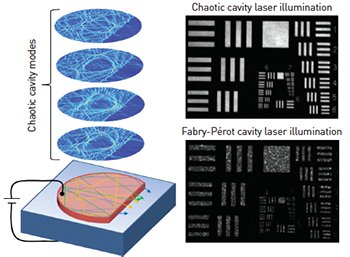 A D-shaped chaotic cavity supports a large number of modes with similar threshold, enabling highly multimode, speckle-free lasing.
A D-shaped chaotic cavity supports a large number of modes with similar threshold, enabling highly multimode, speckle-free lasing.
Despite their spectral brightness, high efficiency, and spectral control, lasers have not been widely used for full-field imaging and display applications, because the high coherence of existing lasers causes artifacts such as speckle. Instead, low-coherence sources such as lamps and LEDs are typically used, even though they are not bright enough for high-speed imaging or wide-area projection. Alternatively, lasers have been used in combination with a rotating diffuser for time-averaging of speckle, or in a scanning modality with a focused spot. These approaches, however, add complexity and increase image acquisition time.
To enable high-speed laser imaging without this complexity, we recently showed that a chaotic microcavity laser can produce inherently speckle-free emission.1 This electrically pumped on-chip semiconductor laser is easy to fabricate, offering a compact and low-cost illumination source for a wide range of imaging applications, from high-speed microscopy to handheld laser display and machine vision.
In a chaotic cavity, the motion of light rays exhibits chaos.2 An example is a simple D-shaped dielectric disk, in which light is confined by specular reflections at the boundary. Compared with a regular cavity such as a circular disk, the chaotic microcavity supports many modes with similar lasing thresholds; these modes are delocalized over the entire cavity, suppressing the competition for gain. This makes it possible to achieve highly multimode lasing in a chaotic cavity. Each mode has a distinct emission pattern, and the combined emission exhibits low spatial coherence.
We fabricated the D-shaped laser using a commercial laser diode wafer and standard fabrication with photolithography and wet chemical etching. Lasing was achieved at room temperature with electrical current injection. With around 1,000 modes lasing simultaneously, the speckle contrast is roughly 3 percent, compared with much higher speckle contrast for a Fabry–Pérot cavity and a circular cavity fabricated on the same chip, for which strong mode competition limited the number of lasing modes.
The D-cavity laser provided some 40 dB higher power per mode than an LED, which distributes emission over many more modes. To reduce the speckle contrast to an acceptable level, only 1,000 modes are needed. Hence, the chaotic laser provides an effective way of reducing speckle contrast while maintaining high power per mode. Compared with other recently developed speckle-free lasers, such as the dye-based random laser3,4 and the solid-state degenerate laser,5 the electrically pumped chaoticcavity laser is more compact and lower cost, and enables on-chip integration.
Researchers
Brandon Redding, Alex Cerjan, Xue Huang, Minjoo Larry Lee, A. Douglas Stone, Michael
A. Choma and Hui Cao, Yale University, Conn., USA
References
1. B. Redding et al. Proc. Natl. Acad. Sci. USA 112, 1304 (2015).
2. H. Cao et al. Rev. Mod. Phys. 87, 61 (2015).
3. B. Redding et al. Opt. Lett. 36, 3404 (2011).
4. B. Redding et al. Nat. Photon. 6, 355 (2012).
5. M. Nixon et al. Opt. Lett. 38, 3858 (2013).
